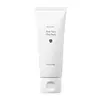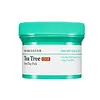What's inside
What's inside
 Key Ingredients
Key Ingredients

 Benefits
Benefits

 Concerns
Concerns

 Ingredients Side-by-side
Ingredients Side-by-side

Water
Skin ConditioningKaolin
AbrasiveGlycerin
HumectantBentonite
AbsorbentDiglycerin
HumectantPropanediol
SolventZea Mays Starch
Absorbent1,2-Hexanediol
Skin ConditioningQuercus Acutissima Fruit Extract
AstringentXanthan Gum
EmulsifyingPolyglycerin-3
HumectantCentella Asiatica Leaf Extract
Skin ConditioningSodium Acrylate/Sodium Acryloyldimethyl Taurate Copolymer
Emulsion StabilisingPolyisobutene
Ethylhexylglycerin
Skin ConditioningQuercus Acutissima Fruit Powder
AstringentButylene Glycol
HumectantMethyl Diisopropyl Propionamide
MaskingDisodium EDTA
Caprylyl/Capryl Glucoside
CleansingSorbitan Oleate
EmulsifyingSaccharide Hydrolysate
HumectantIllite
AbrasiveCentella Asiatica Extract
CleansingSodium Hyaluronate
HumectantMontmorillonite
AbsorbentArtemisia Princeps Leaf Extract
Skin ConditioningMentha Arvensis Extract
MaskingViscum Album Leaf Extract
SoothingHamamelis Virginiana Extract
AntiseborrhoeicHyaluronic Acid
HumectantMentha Suaveolens Leaf Extract
AstringentMentha Viridis Extract
MaskingCI 77891
Cosmetic ColorantCI 77492
Cosmetic ColorantWater, Kaolin, Glycerin, Bentonite, Diglycerin, Propanediol, Zea Mays Starch, 1,2-Hexanediol, Quercus Acutissima Fruit Extract, Xanthan Gum, Polyglycerin-3, Centella Asiatica Leaf Extract, Sodium Acrylate/Sodium Acryloyldimethyl Taurate Copolymer, Polyisobutene, Ethylhexylglycerin, Quercus Acutissima Fruit Powder, Butylene Glycol, Methyl Diisopropyl Propionamide, Disodium EDTA, Caprylyl/Capryl Glucoside, Sorbitan Oleate, Saccharide Hydrolysate, Illite, Centella Asiatica Extract, Sodium Hyaluronate, Montmorillonite, Artemisia Princeps Leaf Extract, Mentha Arvensis Extract, Viscum Album Leaf Extract, Hamamelis Virginiana Extract, Hyaluronic Acid, Mentha Suaveolens Leaf Extract, Mentha Viridis Extract, CI 77891, CI 77492
Water
Skin ConditioningKaolin
AbrasiveDipropylene Glycol
HumectantCentella Asiatica Extract
CleansingMelaleuca Alternifolia Leaf Extract
PerfumingBentonite
AbsorbentBetaine
HumectantAlcohol Denat.
AntimicrobialSilica
Abrasive1,2-Hexanediol
Skin ConditioningPolyglyceryl-4 Caprate
EmulsifyingCoco-Glucoside
CleansingCellulose
AbsorbentMelaleuca Alternifolia Flower/Leaf/Stem Extract
Skin ConditioningSodium Hyaluronate
HumectantCalamine
AbsorbentXanthan Gum
EmulsifyingChlorella Vulgaris Powder
Skin ConditioningGluconolactone
Skin ConditioningTriethoxycaprylylsilane
Illite
AbrasiveMontmorillonite
AbsorbentManicouagan Clay
AbsorbentCanadian Colloidal Clay
Skin ConditioningHydrolyzed Sodium Hyaluronate
Skin ConditioningHydrolyzed Hyaluronic Acid
HumectantHectorite
AbsorbentHydroxyacetophenone
AntioxidantEthylhexylglycerin
Skin ConditioningWater, Kaolin, Dipropylene Glycol, Centella Asiatica Extract, Melaleuca Alternifolia Leaf Extract, Bentonite, Betaine, Alcohol Denat., Silica, 1,2-Hexanediol, Polyglyceryl-4 Caprate, Coco-Glucoside, Cellulose, Melaleuca Alternifolia Flower/Leaf/Stem Extract, Sodium Hyaluronate, Calamine, Xanthan Gum, Chlorella Vulgaris Powder, Gluconolactone, Triethoxycaprylylsilane, Illite, Montmorillonite, Manicouagan Clay, Canadian Colloidal Clay, Hydrolyzed Sodium Hyaluronate, Hydrolyzed Hyaluronic Acid, Hectorite, Hydroxyacetophenone, Ethylhexylglycerin
 Reviews
Reviews

Ingredients Explained
These ingredients are found in both products.
Ingredients higher up in an ingredient list are typically present in a larger amount.
1,2-Hexanediol is a synthetic liquid and another multi-functional powerhouse.
It is a:
- Humectant, drawing moisture into the skin
- Emollient, helping to soften skin
- Solvent, dispersing and stabilizing formulas
- Preservative booster, enhancing the antimicrobial activity of other preservatives
Bentonite is an aluminium phyllosilicate clay with great absorbent properties. The name 'bentonite' comes from the area where the largest source is found: Fort Benton, Wyoming.
As a clay, bentonite is often used to absorb excess oil and provide exfoliation. It has also been shown to have some antibacterial and anti-inflammatory properties. Studies show bentonite was effective at calming dermatitis from poison ivy and in diaper dermatitis of infants. Bentonite has also been shown to act as a barrier against toxic compounds on your skin.
Sunscreens containing bentonite display higher water resistance and stay on the skin for much longer. The sunscreens containing bentonite also show higher potency and UV light absorbtion.
Bentonite is naturally created from volcanic ash and several natural weathering/hydrothermal processes.
A common usage of bentonite is removing excess protein from white wines. Bentonite contains a property of being able to absorb large amounts of protein from aqueous solutions.
Phyllosilicate clay has a structure formed by sheets.
Learn more about BentoniteCentella Asiatica Extract (Centella) is derived from an herb native to Southeast Asia. It is famous for its anti-inflammatory and soothing properties.
Centella is rich in antioxidants and amino acids, such as Madecassic Acid and Asiaticoside.
Studies show the compounds in centella help with:
The combination of all these properties makes centella effective at soothing, hydrating, and protecting the skin.
Other great components of centella include Vitamin A, vitamin C, several B vitamins, and Asiatic Acid.
Fun fact: Centella has been used as a medicine and in food for many centuries. As a medicine, it is used to treat burns, scratches, and wounds.
Learn more about Centella Asiatica ExtractEthylhexylglycerin (we can't pronounce this either) is commonly used as a preservative and skin softener. It is derived from glyceryl.
You might see Ethylhexylglycerin often paired with other preservatives such as phenoxyethanol. Ethylhexylglycerin has been found to increase the effectiveness of these other preservatives.
Illite is an exfoliant.
Kaolin is a clay. It is used for oil control and to help minimize pores. Like other clays, kaolin has the ability to absorb excess sebum or oil. This can help clean out pores and mattify the skin.
Some types of kaolin may have exfoliating properties. When water is added to kaolin, it becomes a paste with small abrasive particles.
Most kaolin is a white color, but may be pink/orange/red depending on where it comes from.
The name 'kaolin' comes from a Chinese village named 'Gaoling'. Kaolin clay comes from rocks rich in kaolinite. Kaolinite, the mineral, has a silicate layered structure. Kaolinite is formed from chemical weathering of aluminum siilicate minerals.
Besides skincare, kaolin is commonly used to make glossy paper, in ceramics, toothpaste, and as medicine to soothe stomach issues.
Learn more about KaolinMontmorillonite is a clay (aluminomagnesium silicate) with strong absorption properties. It has a similar pH to skin.
This clay is named after Montmorillon in France.
Learn about other types of clay, such as Kaolin, Bentonite, or Fuller's Earth.
Learn more about MontmorilloniteSodium Hyaluronate is hyaluronic acid's salt form. It is commonly derived from the sodium salt of hyaluronic acid.
Like hyaluronic acid, it is great at holding water and acts as a humectant. This makes it a great skin hydrating ingredient.
Sodium Hyaluronate is naturally occurring in our bodies and is mostly found in eye fluid and joints.
These are some other common types of Hyaluronic Acid:
Learn more about Sodium HyaluronateWater. It's the most common cosmetic ingredient of all. You'll usually see it at the top of ingredient lists, meaning that it makes up the largest part of the product.
So why is it so popular? Water most often acts as a solvent - this means that it helps dissolve other ingredients into the formulation.
You'll also recognize water as that liquid we all need to stay alive. If you see this, drink a glass of water. Stay hydrated!
Learn more about WaterXanthan gum is used as a stabilizer and thickener within cosmetic products. It helps give products a sticky, thick feeling - preventing them from being too runny.
On the technical side of things, xanthan gum is a polysaccharide - a combination consisting of multiple sugar molecules bonded together.
Xanthan gum is a pretty common and great ingredient. It is a natural, non-toxic, non-irritating ingredient that is also commonly used in food products.
Learn more about Xanthan Gum